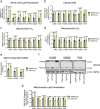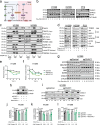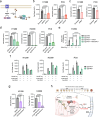Mitochondrial respiratory function is preserved under cysteine starvation via glutathione catabolism in NSCLC
- PMID: 38762605
- PMCID: PMC11102494
- DOI: 10.1038/s41467-024-48695-2
Mitochondrial respiratory function is preserved under cysteine starvation via glutathione catabolism in NSCLC
Abstract
Cysteine metabolism occurs across cellular compartments to support diverse biological functions and prevent the induction of ferroptosis. Though the disruption of cytosolic cysteine metabolism is implicated in this form of cell death, it is unknown whether the substantial cysteine metabolism resident within the mitochondria is similarly pertinent to ferroptosis. Here, we show that despite the rapid depletion of intracellular cysteine upon loss of extracellular cystine, cysteine-dependent synthesis of Fe-S clusters persists in the mitochondria of lung cancer cells. This promotes a retention of respiratory function and a maintenance of the mitochondrial redox state. Under these limiting conditions, we find that glutathione catabolism by CHAC1 supports the mitochondrial cysteine pool to sustain the function of the Fe-S proteins critical to oxidative metabolism. We find that disrupting Fe-S cluster synthesis under cysteine restriction protects against the induction of ferroptosis, suggesting that the preservation of mitochondrial function is antagonistic to survival under starved conditions. Overall, our findings implicate mitochondrial cysteine metabolism in the induction of ferroptosis and reveal a mechanism of mitochondrial resilience in response to nutrient stress.
© 2024. The Author(s).
Conflict of interest statement
The authors declare no competing interests.
Figures






Similar articles
-
NFS1 undergoes positive selection in lung tumours and protects cells from ferroptosis.Nature. 2017 Nov 30;551(7682):639-643. doi: 10.1038/nature24637. Epub 2017 Nov 22. Nature. 2017. PMID: 29168506 Free PMC article.
-
Hydrogen sulfide-mediated persulfidation regulates homocysteine metabolism and enhances ferroptosis in non-small cell lung cancer.Mol Cell. 2024 Oct 17;84(20):4016-4030.e6. doi: 10.1016/j.molcel.2024.08.035. Epub 2024 Sep 24. Mol Cell. 2024. PMID: 39321805
-
COX7A1 enhances the sensitivity of human NSCLC cells to cystine deprivation-induced ferroptosis via regulating mitochondrial metabolism.Cell Death Dis. 2022 Nov 23;13(11):988. doi: 10.1038/s41419-022-05430-3. Cell Death Dis. 2022. PMID: 36418320 Free PMC article.
-
Biological insights in non-small cell lung cancer.Cancer Biol Med. 2023 Jun 28;20(7):500-18. doi: 10.20892/j.issn.2095-3941.2023.0108. Cancer Biol Med. 2023. PMID: 37381723 Free PMC article. Review.
-
Unresolved questions regarding cellular cysteine sources and their possible relationships to ferroptosis.Adv Cancer Res. 2024;162:1-44. doi: 10.1016/bs.acr.2024.04.001. Epub 2024 May 3. Adv Cancer Res. 2024. PMID: 39069366 Free PMC article. Review.
Cited by
-
NDUFA8 promotes cell viability and inhibits ferroptosis and cisplatin sensitivity by stabilizing Fe-S clusters in cervical cancer.Naunyn Schmiedebergs Arch Pharmacol. 2025 May 8. doi: 10.1007/s00210-025-04237-1. Online ahead of print. Naunyn Schmiedebergs Arch Pharmacol. 2025. PMID: 40335672
-
From mitochondrial dysregulation to ferroptosis: Exploring new strategies and challenges in radioimmunotherapy (Review).Int J Oncol. 2025 Sep;67(3):76. doi: 10.3892/ijo.2025.5781. Epub 2025 Aug 8. Int J Oncol. 2025. PMID: 40776761 Free PMC article. Review.
-
Ferroptosis-inducing nanomedicine and targeted short peptide for synergistic treatment of hepatocellular carcinoma.J Nanobiotechnology. 2024 Sep 3;22(1):533. doi: 10.1186/s12951-024-02808-7. J Nanobiotechnology. 2024. PMID: 39223666 Free PMC article.
-
Differential Expression of Circulating miRNAs and Carfilzomib-Related Cardiovascular Adverse Events in Patients with Multiple Myeloma.Int J Mol Sci. 2024 Jul 16;25(14):7795. doi: 10.3390/ijms25147795. Int J Mol Sci. 2024. PMID: 39063038 Free PMC article.
-
CHAC1: a master regulator of oxidative stress and ferroptosis in human diseases and cancers.Front Cell Dev Biol. 2024 Oct 29;12:1458716. doi: 10.3389/fcell.2024.1458716. eCollection 2024. Front Cell Dev Biol. 2024. PMID: 39534397 Free PMC article. Review.
References
MeSH terms
Substances
Grants and funding
- P01CA250984/U.S. Department of Health & Human Services | NIH | National Cancer Institute (NCI)
- R37CA230042/U.S. Department of Health & Human Services | NIH | National Cancer Institute (NCI)
- P01 CA250984/CA/NCI NIH HHS/United States
- R37 CA230042/CA/NCI NIH HHS/United States
- P30 CA076292/CA/NCI NIH HHS/United States
LinkOut - more resources
Full Text Sources
Medical
Research Materials
Miscellaneous

